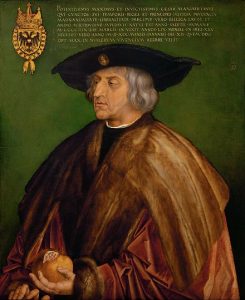Caring for your Jewellery while abroad
Heading to the Mediterranean this season? While you soak up the sun, make sure your diamonds are just as radiant when...

Archduke Maximilian of Austria
Although diamonds were used as ring ornamentation for many centuries, most experts date the origin of the diamond engagement ring to the late 15th century. The man credited with starting this romantic tradition is a little known Archduke from Austria. Who in actual fact presented his love interest with a specially crafted diamond ring without any sense of amorous affection whatsoever.
Archduke Maximilian of Austria used the diamond ring as a political tool to win the hand of Mary of Burgundy, in an attempt at expanding his kingdom. But today, diamond engagement rings possess far more romantic connotations. So how did our love affair with the diamond ring evolve?
Here’s a brief timeline marking some of the key milestones in the evolution of the Diamond Engagement Ring History. From political bargaining chip to love token.
1215: The notion of a “period of engagement” is created when Pope Innocent III institutes a mandatory waiting period between betrothal and marriage.
1477: Archduke Maximilian of Austria proposes to Mary of Burgundy with a ring set with thin, flat pieces of diamonds crafted into the shape of the letter “M.”
The 1700s: Silver “poesy rings” engraved with bombastic and over-the-top sayings become increasingly popular throughout Western Europe.
The 1800s: The Victorians popularise ornate engagement rings that mix diamonds with other precious gemstones and metals.
1867: Large reserves of diamonds are discovered in South Africa, thus greatly boosting diamond supply.
1880: Cecil Rhodes establishes the DeBeers Mining Company, as a cooperative of hundreds of diamond miners.
The 1890s: Affordable diamond engagement rings, marketed to the masses, appear in mail-order catalogues.
The 1930s: As demand for diamonds declines due to the depression, De Beers shareholders are bought out by the Oppenheimer family. The company launches an aggressive marketing campaign in the US designed to rekindle demand. The campaign included the now popular use of celebrity endorsement. Within three years of launching, the sale of diamonds in the US rises by 50%.
1947: De Beers coins the iconic phrase, “A Diamond is Forever.”
1965: By 1965, 80% of all new brides in America own a diamond engagement ring.
2000: The World Diamond Council instigates the UN-backed Kimberly Process in order to oversee the industry in a bid to bring an end to the exploitation of diamonds for illicit purposes.
So while the use of the diamond ring as a symbol of betrothal is a surprisingly recent tradition. It’s a custom so firmly embedded in our culture that it’s hard to imagine getting engaged without one. After all, nothing symbolises the everlasting love between a man and a woman better than a diamond, which does indeed, last forever.
Shop our engagement rings here.
Heading to the Mediterranean this season? While you soak up the sun, make sure your diamonds are just as radiant when...
When it comes to purchasing an engagement ring, the diamond isn’t the only star of the show. The setting style can...
Investing in gold jewellery is a time-honoured tradition that continues to shine in 2025. Gold has been a reliable...